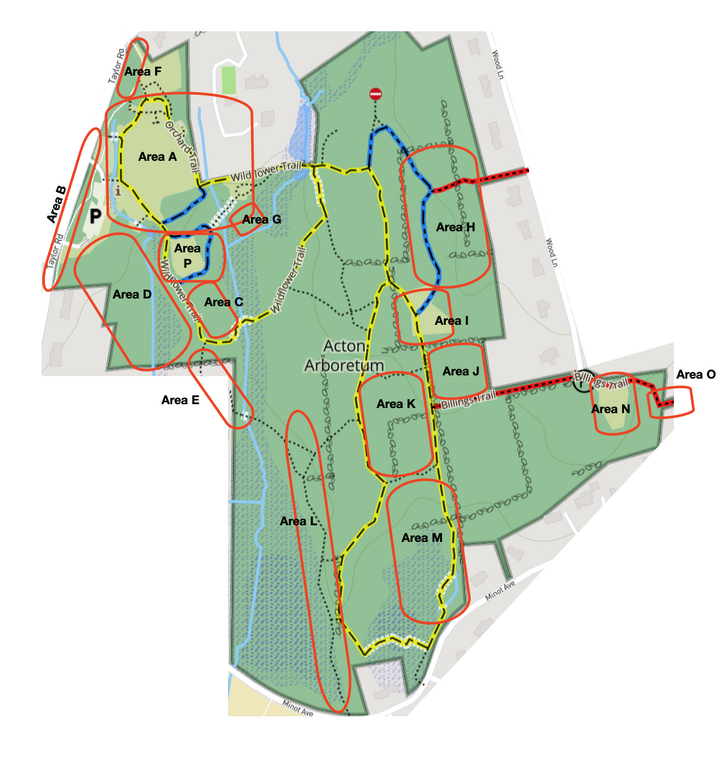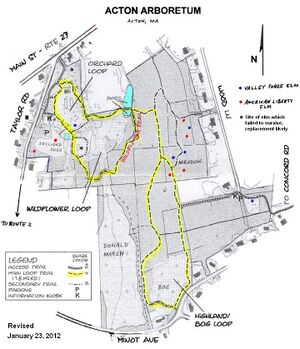Arboretum: Difference between revisions
Watlington (talk | contribs) m (Added section on American Ems) |
Watlington (talk | contribs) m (Corrected my horrible grammar. Added link to Local Elm ID page.) |
||
| Line 44: | Line 44: | ||
== Area J - The Indian Mounds == | == Area J - The Indian Mounds == | ||
This is forested area to the northeast of the intersection of the Billings trail and the Yellow Bog Loop trail. While the overgrowth restrains the growth of | This is forested area to the northeast of the intersection of the Billings trail and the Yellow Bog Loop trail. While the overgrowth restrains the growth of invasive plants, there is still Glossy Buckthorn and Asian Bittersweet growth in this area. Note that any plant removal around the Indian rock mounds should avoid disturbing them. | ||
Last cleared around 2021. | Last cleared around 2021. | ||
| Line 66: | Line 66: | ||
This meadow sees infrequent mowing (should be yearly). It is infested with Asian Bittersweet and Glossy Buckthorn. | This meadow sees infrequent mowing (should be yearly). It is infested with Asian Bittersweet and Glossy Buckthorn. | ||
There is an cluster of Aspen Saplings growing in the northeast corner of that meadow, which should probably be encouraged instead of mowed. Also in the north side of the meadow (near the trail) is an Valley Forge variant American Elm tree. | There is an cluster of Aspen Saplings growing in the northeast corner of that meadow, which should probably be encouraged instead of mowed (Despite mowing around it with a field mower, it was mowed in Fall 2023). Also in the north side of the meadow (near the trail) is an Valley Forge variant American Elm tree. | ||
In 2023, | In 2023, all edges of the meadow were cleared of invasive plants, and all trees in and along the meadow were cleared of Asian Bittersweet. | ||
== Area O - The Billings Trail == | == Area O - The Billings Trail == | ||
| Line 76: | Line 76: | ||
== American Elms == | == American Elms == | ||
There are [https://www.elmpost.org/ Dutch Elm Disease Resistant American Elm trees] planted throughout the Arboretum. These should get special attention to keep them free from | There are [https://www.elmpost.org/ Dutch Elm Disease Resistant American Elm trees] planted throughout the Arboretum. These should get special attention to keep them free from invasive plants. Their location is provided in this map (mirrored from [https://www.elmpost.org/arboretm.htm here)]: As of Nov. 2023, all of the ones indicated as living in that diagram were found alive. | ||
[[File:Arboretm.jpg|thumb]] | [[File:Arboretm.jpg|thumb]][[Identifying Local Elm Trees|Identifying Local Elm Species]] | ||
Revision as of 03:59, 12 January 2024
The Acton Arboretum comprises both the well-manicured Orchard area, and a wilder wooded portion, with swamps, eskers, bogs, and inner meadows. Invasive plants are found throughout.

Area A - The Orchard
Area A comprises the "Orchard Loop" plus the new China Garden. Invasives in this area are MultiFlora Rose, Asian Bittersweet, Mugwort, Bush Honeysuckle, and Garlic Mustard. The areas near the paths are continuously being cleared as Ruby gets her daily constitutional.
In fall 2022, all meadow areas in Area A were mowed (tractor). Yearly mowing is recommended.
Area B - Taylor Rd Border
Area B is the area between the sidewalk and Taylor Rd., in the area between the exit and the southern border of the Arboretum. Invasives in this area are largely Glossy Buckthorn and Mugwort, with some MultiFlora Rose, Bush Honeysuckle, and Asian Bittersweet thrown in. Last cleared on 10/18/23 (although there is still a large Bush Honeysuckle at the southern end which hasn't been cut.)
Area C - Inside the WildFlower Trail
This is an area cleared in the past few years (2019 ?). There is still considerable regrowth from roots of Asian Bittersweet, Bush Honeysuckle and Multiflora Rose which needs clearing.
Area D - The Neglected Area
Area D starts at the parking lot and continues downhill between the Arboretum border and the maintained Arboretum lands. Infested with large Bush Honeysuckle overgrown with Asian Bittersweet. Multiflora rose is also scattered throughout. Clearing started in 2022.
Area E - The Donald Land Crossing
Area E is the area around the start of the swamp trail. It is infested with large Bush Honeysuckle, Glossy Buckthorn and Multiflora Rose overgrown with Asian Bittersweet. Lots of Poison Ivy and Raspberries as well, which while desired have a tendency to grow into the trail.
In 2022 (?), there was an effort by volunteers to cut back the encroaching vegetation, especially in the area close to Mary's Brook. There was a pass made a clearing regrowth in summer of 2023.
Area F - The Taylor Rd. Swamp
This area is the Taylor Rd. side of the swamp at the northeast corner of the Arboretum. It has large clumps of Glossy Buckthorn and one scary infestation of Japanese Knotweed.
Unclear when it was last worked.
Area G - The new Garlic Mustard patch
In 2023, Jim Snyder-Grant discovered a new infestation of Garlic Mustard in this area, hidden among the Bush Honeysuckle.
Area H - The Vulcan Ear Loop
This area is completely infested with invasive plants: Bush Honeysuckle, Glossy Buckthorn and Multiflora Rose overgrown with Asian Bittersweet. There were also some Norway Maples, but they were girded and killed in the late 2000s.
The Blue path through this (the Vulcan Ear loop) requires mowing two - three times a year to keep it clear, along with at least one pass at cutting back the larger intruding bush invasives by hand.
There has been no attempt to deal with this area.
Area I - The Inner Meadow
Bordering the Vulcan Ear Loop is the Arboretum Inner Meadow. This jewel has seen its mowing sadly neglected, which has resulted in an overgrowth of Asian Bittersweet and Glossy Buckthorn.
The entire meadow was mowed in 2023.
The eastern half of the meadow got a good mowing in the fall of 2022. The western half hasn't been mowed since 2020.
Area J - The Indian Mounds
This is forested area to the northeast of the intersection of the Billings trail and the Yellow Bog Loop trail. While the overgrowth restrains the growth of invasive plants, there is still Glossy Buckthorn and Asian Bittersweet growth in this area. Note that any plant removal around the Indian rock mounds should avoid disturbing them.
Last cleared around 2021.
Area K - Inside the Bog Loop
This area started seeing invasive plant clearing in 2017, and is now starting to stabilize with little remaining regrowth. The culprits were Glossy Buckthorn and Multiflora Rose overgrown with Asian Bittersweet. There was also one large Winged Euonymus which had spread to dozens of little Winged Euonymus plants.
The area was last walked through in 2023.
Area L - The Swamp Trail
The continuation of the Swamp trail has lots of Glossy Buckthorn growing around it, with occasional Multiflora Rose, Asian Bittersweet, and Japanese Barberry.
It is unclear when it was last completely cleared.
Area M - Lower Bog Loop
This area is infested with Glossy Buckthorn and Multiflora Rose.
It is unclear if it has ever seen any removal efforts.
Area N - The Wood Lane Meadow
This meadow sees infrequent mowing (should be yearly). It is infested with Asian Bittersweet and Glossy Buckthorn.
There is an cluster of Aspen Saplings growing in the northeast corner of that meadow, which should probably be encouraged instead of mowed (Despite mowing around it with a field mower, it was mowed in Fall 2023). Also in the north side of the meadow (near the trail) is an Valley Forge variant American Elm tree.
In 2023, all edges of the meadow were cleared of invasive plants, and all trees in and along the meadow were cleared of Asian Bittersweet.
Area O - The Billings Trail
This is the part of the Billing Trail leading out to Concord Rd. from the (current) end of Wood Lane. The edges of the trail are infested with Asian Bittersweet, Glossy Buckthorn, and Norway Maple.
A sweep was made all the way down the trail in 2023. The large number of girded Norway Maples will need another sweep to remove regrowth in early 2024.
American Elms
There are Dutch Elm Disease Resistant American Elm trees planted throughout the Arboretum. These should get special attention to keep them free from invasive plants. Their location is provided in this map (mirrored from here): As of Nov. 2023, all of the ones indicated as living in that diagram were found alive.
